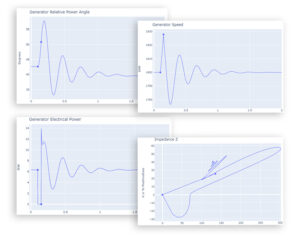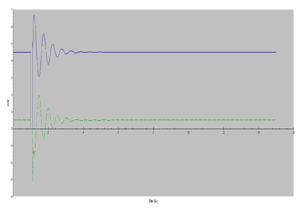The current power system is connected by many centralized synchronous generators and distributed power sources, creating a complex system to provide electricity for production, business and human activities, so the management and operation are posing many great challenges to maintain the stability and reliability of the power system. During the operation process, the power system has to face many abnormalities, disturbances, incidents that cause instability and interruption of power supply, this requires the power system to be monitored, calculated, designed to respond well and quickly to disturbances to bring the system back to a stable state as quickly as possible within the operating limits.
Transient stability analysis is the study and analysis of the ability of the generator to maintain synchronization and the ability of the system to respond and maintain a stable equilibrium when subjected to transient disturbances, whether the disturbance is small or large. System disturbances can be of various types such as sudden load changes, short circuit faults, switching processes, large motor starts, sudden loss of generator or power source, sudden load shedding, etc.
♦ The stability of a system refers to the ability of a system to return to a steady state or not lose synchronism when subjected to a disturbance. To achieve this steady state, the system must maintain stability in terms of rotor angle stability, frequency stability and voltage stability. The stability of a power system is generally classified into static stability, dynamic stability and transient stability as described below:
– Static stability Dynamic stability is the ability of the system to return to a stable state after a very small and slow disturbance. The disturbance can be caused by a gradual increase in power or load current.
– Dynamic stability is the ability of the system to return to a stable state after a very small disturbance (disturbance occurring within 10 to 30 seconds). Small disturbances are mainly caused by fluctuations in the load or power source.
– Transient stability is the ability of the power system to return to a stable state after a large disturbance. Large disturbances occur due to sudden load shedding, line switching; short circuit faults, generator loss, sudden power loss, etc.


♦ The parameters, data information and evaluation provided when performing transient stability analysis include:
– Consider the effects of disturbances on voltage, frequency, generator rotor angle, power flow, rotational speed, etc.
– Evaluate the system response to design appropriate load shedding schemes when the system is under-frequency and under-voltage.
– Evaluate the fault clearance time to design or evaluate appropriate protection schemes and switching times.
– Evaluate the selection and settings of voltage and frequency protection relays related to amplitude and operating time.
– Consider the voltage recovery response of the system.
– Consider whether the synchronous stability of the generator rotor angle is within the allowable limits.
♦ Applicable standards:
– IEEE 399: Standard for the Analysis of Industrial and Commercial Power Systems.
– IEEE 1110: Standard for Generator Stability Analysis in Power Systems
– ANSI/NEMA C50.41: Standard for Asynchronous Motors for Power Systems
– Equipment Manufacturer Standards

